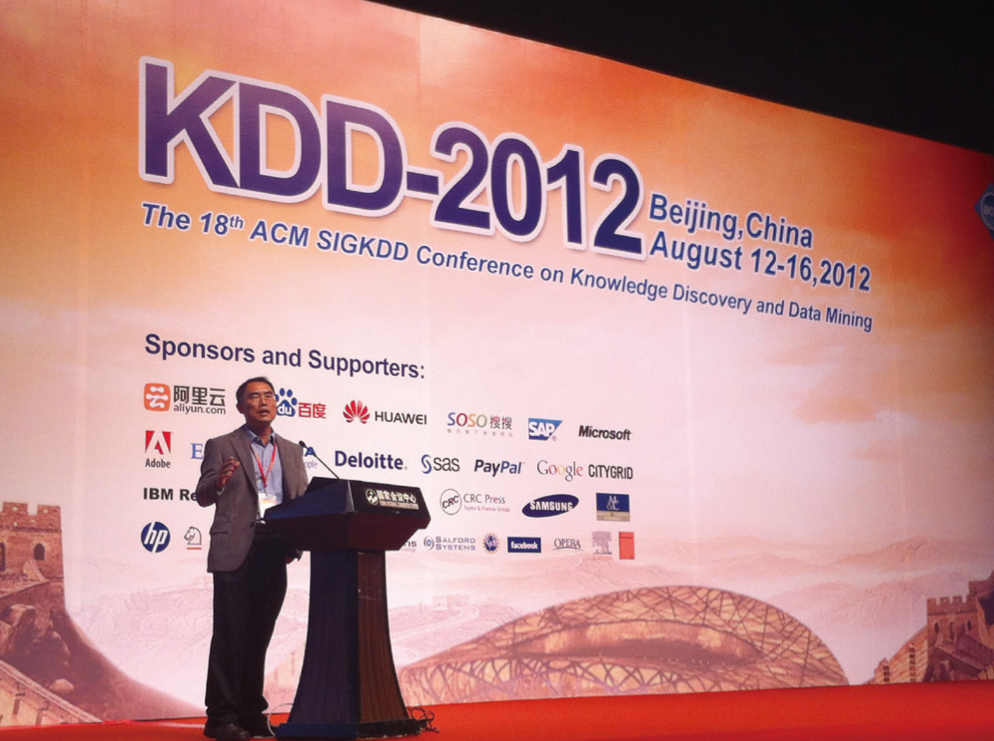
Professor Yang Qiang
In this information age, data are at the center of most of our daily activities. Imagine you
start your day and head off to work. Your car’s movement data are captured via GPS devices
and smart phones. When you visit the web and search for a specific product, your query
and clicking actions are recorded in a data store known as query log data. When you
take a picture using your camera, one or more image data are created. We are truly in the
age of the so-called Big Data, where the data flows in even larger volume, wider variety
and faster speed. When we accumulate so much data, it is important for us to search for
knowledge and useful patterns in the data via specialized software techniques. These data
analytic software technology is collectively known as data mining, where the key issue
is to uncover and make sense of hidden knowledge in the data.
This project aims to develop a new technology that can find interesting patterns
and knowledge by considering two or more sources of different, but related, data
together to discover something new. For example, suppose one has read many books
on butterfly. Does this help the person in recognizing a new species of butterfly by
looking at their images? Humans seem to be able to do this smoothly, by transferring
knowledge learned from one domain to another. For example, having knowledge in
chess makes it easier for us to learn checker games, and know how to program in C++
giving us an advantage in learning Java. These are the examples of heterogeneous
transfer learning, a subject of this project, where the transfer of knowledge happens
from one application to another, in our daily lives. For example, when reading a book, we
form images of faces and scenes in our minds, which could benefit our learning to recognize
scenes and faces in photos. It could save us a lot of efforts and expense in building new
models for recognizing new scenes and faces.
In data mining, a feature space is needed to represent data and different areas of
application have different feature spaces. For example, in images, we use pixels, lines
and areas to represent an image. In text documents, we use words and phrases to
represent features. Heterogeneous transfer learning refers to learning in one domain
(text) and then transferring the learned knowledge to another newer or more difficult domain
(images).
A major limitation in heterogeneous transfer learning is the gap between two feature
spaces and the differences between two distributions. These are two major
assumptions in data mining that are often broken in real world practice. To overcome this limitation,
we have developed a novel heterogeneous transfer learning method to build up a
mapping between two related feature spaces which enable the knowledge transfer. To do
this, we search for a rich online resource such as Wikipedia or an image repository such as
Flickr, and use the related images and tags to build a ‘bridge’ between two feature spaces.
To resolve the distribution differences, we add an information filter to ensure that the
distance between two learning domains is minimized.
|
|
Our research has generated very impressive results. In 2010, MIT Technology Review
(a popular Silicon Valley IT Magazine) ran an article to report
our application of heterogeneous transfer learning in online
advertisement domains. In this application, we allow a user to present an image as input.
Then, the system that we have developed (known as ViCAD) then finds a set of similar
images and text documents that are relevant to the semantic meaning in the image. Some
of these documents and images can be advertisements, thus generating value for the
online search-engine companies. The engine that enabled this learns a mapping between
text and images via heterogeneous transfer learning as a result from our project.

Participation in The 18th ACM SIGKDD Conference on Knowledge Discovery and
Data Mining
After the success of ViCAD project, we continued to explore the practical possibility
of heterogeneous transfer learning to another promising application that is image
classification problem. Traditionally, building a good image classifier requires sufficient
labelled data, which are usually hard to obtain. But, our approach can leverage the
knowledge from text documents to images, thus help better in classifying images. In
our recent paper published in AAAI2011, not only unlabelled images, but also
unlabelled text documents, can get rid of image classification problem. Specifically, by
using related images with tags, we build a bridge to transfer discriminative information
in text documents to target image domain. Comprehensive experiments have been
carried out on Caltech-256 dataset (a popular dataset for image classification). We find
that our algorithm can improve by 10% in accuracy, after reading 200 unlabelled text
documents. In a broader sense, our research in Heterogeneous Transfer Learning for
Image Classification (HTLIC) also sheds light to the general understanding of how text
and images are related and how to use extra knowledge to help a learning task.
Another example of our achievement is illustrated in an international data-mining
competition. In 2011, our team together with the mainland partner won the third
place in 2011 ACM KDDCUP data mining competition, a well-known international competition
attended by many famous teams in the world, on the topic of Yahoo! Music
Recommendation among over 2,000 international teams. Our work is also used
by Tencent Inc. in their VIP recommendation on Chinese Weibo (microblogging), which involves more than one billion user accounts. Our transfer learning solution
allows knowledge about user preferences in the QQ network to empower
the new Weibo network of users with a significant increase of successful
recommendation. We are currently working on how to enable knowledge transfer from
Chinese poetry to traditional Chinese music, which would involve a multidisciplinary team
of writers, artists and computer scientists.
Prof Yang Qiang
Department of Computer
Science and Engineering
The University of Science and Technology
qyang@ust.hk
|
